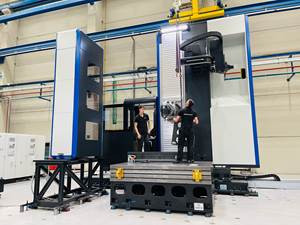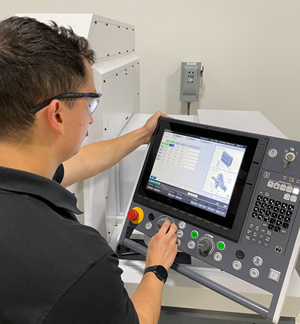Pinch Milling from Top to Bottom
A multitasking (turnmill) machine that can mill a workpiece top and bottom at the same time has advantages for long, slender workpieces such as turbine blades, propellers and aerospace structural components. Includes video.
Share






Pinch milling is a technique for machining long, slender workpieces held between opposite workholding spindles on a multitasking machine equipped with upper and lower milling spindles. This technique was developed by the Machining Technology Laboratory (MTL) at Mori Seiki USA (Hoffman Estates, Illinois) as an application for the company’s NT4300 machines. The related video captures one of these machines milling an aluminum propeller blade. Pinch milling is a lot like pinch turning, a technique that has long been used on four-axis lathes.
In pinch turning (also called balanced turning), two opposing, single-point turning tools impinge on the workpiece from opposite sides, thus “pinching” the workpiece in between. The radial forces of the opposing turning tools counteract each other, thereby greatly reducing the tendency of long, slender parts to deflect away from the tool. This also enables heavier cuts for a productivity gain and provides a more accurate cut. Likewise, one of the tools can provide the semi-finishing cut while the other, slightly trailing the opposing tool, provides the finish cut. This reduces the number of passes required to complete the turning operation.
Pinch milling operates along similar lines. Live milling tools in the upper and lower spindle heads machine opposite sides of the workpiece at the same time. This achieves the same effect as the opposing tools in pinch turning. However, pinch milling is quite a bit more complex than pinch turning, explains Greg Hyatt, who heads the MTL and is one of the engineers chiefly involved in developing this technique.
Here is a quick rundown of some of the unusual or unexpected aspects of pinch milling.
• The upper and lower milling tools are following different contouring tool paths that have been carefully coordinated to sync the axis motions. This was a major challenge in CAM programming for this technique. The demo shown in the video uses a multi-axis tool path created in Delcam’s Powermill. Other CAM vendors are now partnering with Mori Seiki to provide pinch milling solutions.
• The upper and lower milling tools are matched to the semi-finish and finish operations to which they are assigned. Thus, these tools may be quite different. For example, the semi-finishing tool may be a ballnose end mill running at speeds and feeds that maximize metal removal, whereas the finishing tool may be a bullnose end mill chosen for the superior surface finish attainable with this type of tool.
• For the application in the video, the finishing tool is mounted in the upper spindle to take advantage of its fifth-axis capability. This allows the tool to be inclined at a 10-degree angle so that cutting action moves away from the center of the tool tip, where cutting edges are the thinnest.
• The workholding spindles at each end of the workpiece provide both tensional and torsional preload on the workpiece. In other words, the spindles put both pulling and twisting forces on the part to improve clamping rigidity. This enhances resistance to cutting forces.
• Because the part can be held more rigidly and is subjected to far less deflection, allowable spindle load can be increased on both spindles. The net effect is multiplied because the spindles are cutting simultaneously. “If depth of cut or feed rate is doubled on both spindles, metal can be removed four times faster then what is attainable with a single spindle,” Mr. Hyatt explains.
According to Mr. Hyatt, the NT4300 is particularly well suited for pinch milling because it is configured with adequate milling capability and precision in both the upper and lower spindle. The CNC, however, had to be upgraded to a model with more processing power to run multi-axis programs simultaneously. Otherwise, the machine is equipped as standard.
In addition to propellers and turbine blades, Mr. Hyatt sees structural aerospace components as one of the most promising applications for pinch milling.
Related Content
Controlling Extreme Cutting Conditions in Large-Part Machining
Newly patented technologies for controlling chatter and vibration during milling, turning and boring operations promise to drastically reduce production time and increase machining performance.
Read MoreSwiss-Type Control Uses CNC Data to Improve Efficiency
Advanced controls for Swiss-type CNC lathes uses machine data to prevent tool collisions, saving setup time and scrap costs.
Read MoreView From My Shop: The Challenge of a One-Man Machine Shop
Mason Montalvo took up the challenge of starting his own shop running manual machine tools to produce complex parts.
Read MoreMultitasking Machines Cut Days From Shop’s Setups
Adopting WFL Millturn machines enabled BWXT to condense operations and setups while also providing a simple way to simulate and secure processes.
Read MoreRead Next
Last Chance! 2025 Top Shops Benchmarking Survey Still Open Through April 30
Don’t miss out! 91ÊÓƵÍøÕ¾ÎÛ's Top Shops Benchmarking Survey is still open — but not for long. This is your last chance to a receive free, customized benchmarking report that includes actionable feedback across several shopfloor and business metrics.
Read MoreMachine Shop MBA
Making Chips and 91ÊÓƵÍøÕ¾ÎÛ are teaming up for a new podcast series called Machine Shop MBA—designed to help manufacturers measure their success against the industry’s best. Through the lens of the Top Shops benchmarking program, the series explores the KPIs that set high-performing shops apart, from machine utilization and first-pass yield to employee engagement and revenue per employee.
Read MoreAMRs Are Moving Into Manufacturing: 4 Considerations for Implementation
AMRs can provide a flexible, easy-to-use automation platform so long as manufacturers choose a suitable task and prepare their facilities.
Read More






















